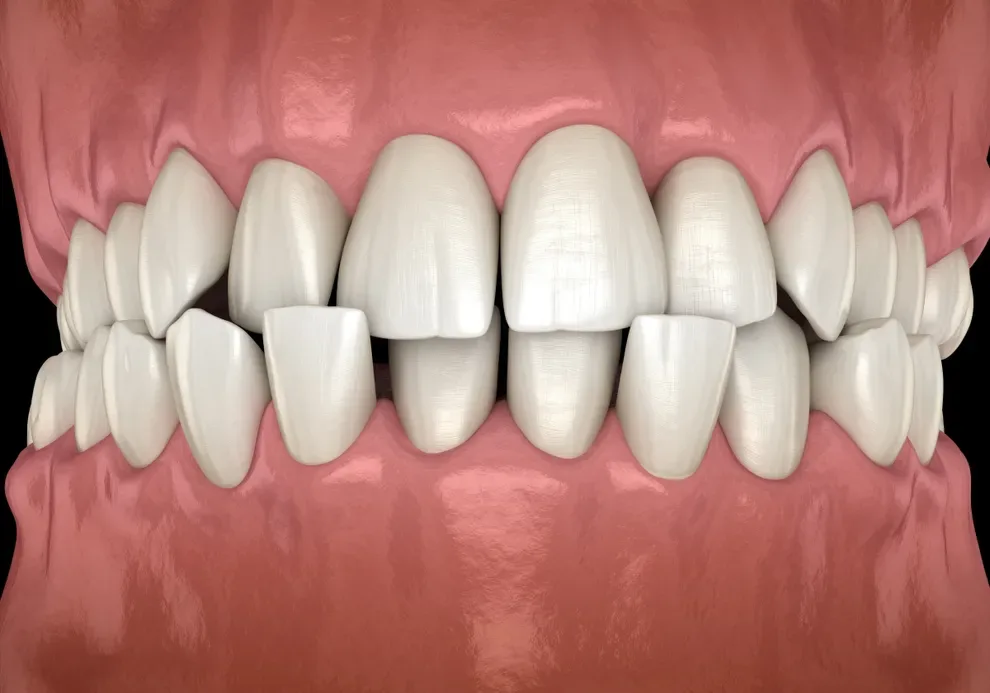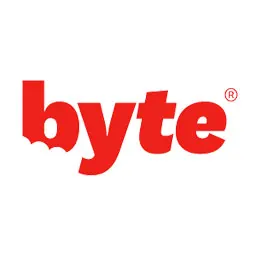Crossbite Treatment

Table of Contents
- Key Facts
- Understanding Crossbites
- Treatments for Crossbites
- Correcting Certain Types
- Clear Aligner Therapy
- Do Crossbites Correct by Themselves?
- How is Crossbite Diagnosed?
- Crossbite Treatment FAQs
- References
A crossbite is a type of malocclusion, or teeth misalignment. With a crossbite, the upper teeth fit inside the lower teeth. This could involve one tooth or multiple teeth. The back and/or front teeth may be affected.
A crossbite is usually caused by genetics, childhood oral habits like thumb sucking or pacifier use, an accident or trauma, or a congenital condition.
Treatments may include jaw surgery, the use of orthodontic devices, tooth removal, replacing missing teeth, braces, or the use of clear aligners.
Key Facts about Crossbite
Crossbite is a type of teeth misalignment, or malocclusion, in which the upper teeth sit inside the lower teeth.
There are two types of crossbite: posterior crossbite (back upper teeth sit inside lower teeth) and anterior crossbite (top lower teeth sit inside lower teeth).
Untreated crossbites can lead to health concerns that include tooth decay, gum disease, jaw problems, pain, and abnormal facial development.
Treatment options for crossbites include jaw surgery, tooth removal, the use of orthodontic devices, braces, and clear aligners.
Understanding Crossbites
You may have crooked teeth or a crooked smile, but these are broad terms that could refer to many underlying causes of misaligned teeth or jaws. These misalignments are called .
One type of malocclusion is a crossbite, which is a misalignment of the upper and lower teeth, so one set covers the outside of the other when they meet. This alignment problem can occur because the upper jaw is larger than the lower jaw or vice versa.
Crossbites at the back of the mouth cause teeth grinding, jaw problems and pain, abnormal facial development, and wear on the teeth. This can lead to decay, tooth damage, and gum disease.
Crossbites often become apparent as a child loses their baby teeth, and their permanent teeth start to come in. This is a period called mixed dentition because not all the permanent teeth have come in.
Dentists try to catch this misalignment early in life because crossbites are simpler to manage and adjust in adolescents and teens than in adults. However, there are still options for adults who have an uncorrected crossbite. Treatment methods range from aligners or braces to surgery.
Treatments for Crossbites
How your crossbite is treated will depend on how severe it is and what’s causing it.
Severe crossbites caused by a jaw misalignment may require jaw surgery. If there’s crowding, a tooth or multiple teeth may need to be removed to give teeth room to move into a corrected position. Even if these procedures are needed, an individual with crossbite will also need orthodontic treatment to treat the malocclusion.
Orthodontic treatments for crossbite include the following:
Although less commonly used for adults because they’re less effective when treating jaws that have already developed, orthodontic devices that influence jaw movement and growth are sometimes included in treatment for crossbites.
These devices include headgear (a banded appliance with wiring on the inside and outside of mouth) and palatal expanders, which may be fixed or removable (applied to the roof of the mouth before being expanded to widen the jaw).
Braces are common treatment for crossbite and involve brackets that are attached to the teeth and connected by wiring and elastics. The wiring is tightened during regular orthodontist adjustment visits. This tightening applies pressure to the teeth, forcing them to move to their corrected position.
Aligners are removable. A series of trays is custom-made to gradually move your teeth from their current locations to their corrected positioning.
Each tray fits comfortably over your teeth and is worn for a week or two before moving on to the next one. After you’ve completed the series, your bite will be fixed.
Correcting Certain Types of Crossbites
Any of the above treatment options may be used to correct either type of crossbite depending upon the individual case and severity, however, some treatments may be more helpful for a specific crossbite type.
Crossbites affecting the front teeth may be corrected with braces or aligners. Sometimes, an orthodontist may use a retainer or other orthodontic device.
Widening the upper teeth and jaw with the use of braces or aligners may be especially useful in correcting crossbites affecting the back teeth. Palatal expanders may also be used.
Clear Aligner Therapy May Help Crossbites
Many adults remember having “metal mouth” as kids and do not want braces again. As a result, they avoid orthodontic treatment, thinking braces are the only option to correct their bite. Fortunately, there are options available that are much less intrusive than traditional braces or other devices.
Depending on the severity of your crossbite, you may be able to use aligners to correct your smile, and they are much subtler than braces. Clear aligners slip over the teeth, and they are often difficult to see unless someone is very close to you. If you have an important meeting or engagement, you can remove the aligners for short periods of time.
For mild-to-moderate cases of crossbite, aligners may offer the most effective and convenient solution. With an average treatment time of 4–6 months, the option of a completely at-home doctor-monitored treatment, and affordable pricing and payment plans, it’s easy to see why clear aligners are the best choice for many teens and adults looking to correct their smile and bite.
If you’re not sure that clear aligners can fix your crossbite, you can take Byte’s 30-second assessment and (if advised) order an easy at-home impression kit to determine if you’re a candidate for aligners. If the impression kit reveals that aligners aren’t an option for you, Byte will refund you.
Do Crossbites Ever Correct on their Own?
While there are instances in which a childhood crossbite corrects itself later in life, this is rare. Some studies suggest that up to 9 percent of crossbites self-correct, but that is the highest estimate.
While many children receive treatment for crossbites at a young age, adults can develop crossbites due to genetics, poor hygiene, health, or diet. Even if you had braces as a child, you may need a bite adjustment later in life.
How is a Crossbite Diagnosed by your Dentist?
In an average, healthy bite with proper alignment, the upper teeth will sit just a little outside of the lower teeth. This is true with the front and back teeth, on all sides of the mouth. When the teeth do not meet correctly in one or more of these dimensions, you have a crossbite.
The American Association of Orthodontists (AAO) defines a crossbite as the abnormal relationship of a tooth or a few teeth to their opposing teeth.
There are two basic types of crossbite:
This is where the top front teeth sit behind the lower front teeth. This may give the appearance of an underbite, where the jaw juts out. Unlike a traditional underbite, an anterior crossbite has more to do with alignment of teeth than the jaw.
This occurs when the back teeth on top bite down inside the back teeth on bottom instead of being slightly outside. About 1 to 16 percent of children develop this bite before their permanent teeth erupt. It is important for pediatric dentists to monitor this crossbite and see how adult teeth might align in relation.
Even though these types of crossbite may not be very visible, they can impact your oral health.
When they are uncorrected in children, the face may grow asymmetrically. Misaligned teeth may mean that you clench your jaw more, or your enamel gets worn down faster because your teeth are at unhealthy angles.
You could have headaches and neck pain from jaw clenching. You may be more likely to get gum disease and cavities because of worn enamel or food particles getting stuck in places that are harder to clean. Your jaw may grow to one side or shift as you get older, which can impact the muscles and tendons around your head.
The best path forward is to correct your crossbite. Talk to your dentist or an aligner company about next steps.
Crossbite Treatment Frequently Asked Questions
Yes. Even severe cases of crossbite can be corrected with proper treatment. For mild and moderate cases of crossbite, treatment is actually easier than ever before with the help of clear aligners.
It’s easier to treat crossbite in childhood and adolescence when the jaw and teeth are still developing. During development, it’s easier to influence movement. Orthodontic devices like palate expanders, for example, might be more effective at this time.
Still, treatment for crossbite is available at any age, especially with modern dental advancements. And treating a crossbite — or any malocclusion or oral health issue — should be a priority for an aging adult.
Malocclusion can lead to decay, gum disease, and problems eating and speaking. Getting treatment for a crossbite can help to correct these issues before they get any worse and lead to problems that could interfere with daily life later on.
Crossbite treatment will depend on how severe the misalignment is. If it’s very severe or caused by a skeletal jaw issue, surgery may be needed. For less extreme cases, braces treatment or orthodontic devices may be used. For mild-to-moderate cases, clear aligners may be the fastest and most convenient option.
If you have a crossbite, that means your teeth aren’t lining up properly. This can cause a lot of problems.
There are likely areas that are hard to clean in your mouth — narrow passageways between crowded or crooked teeth as well as empty areas between gaps. Bad bacteria and food particles can accumulate in these areas, which can lead to decay, gum irritation, and bad breath. Eventually, it could lead to cavities, gum disease, and even tooth loss.
An untreated crossbite can lead to other issues as well, like jaw pain and strain, speech and eating problems, and weakened tooth enamel.
